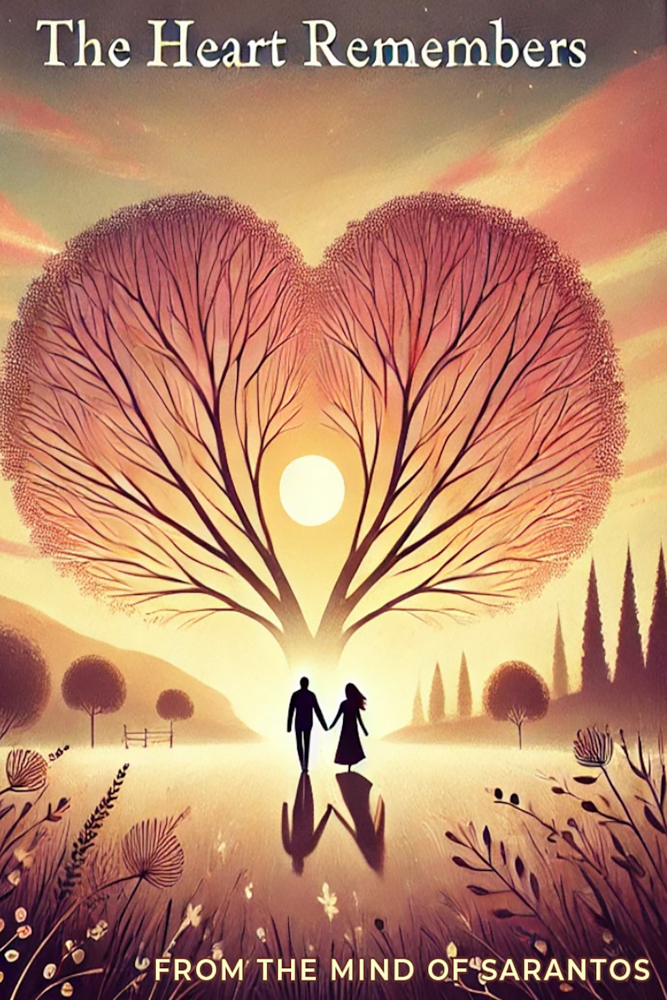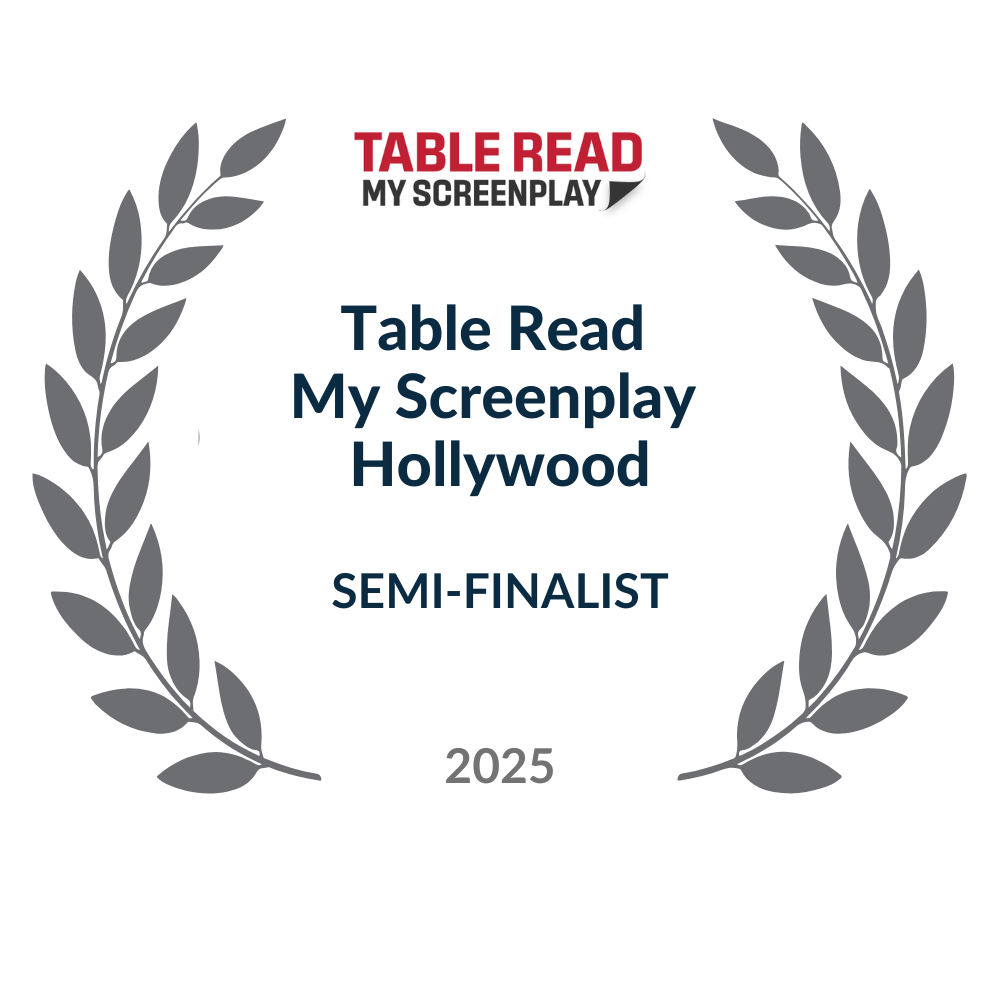
Sarantos Screenplay: The Heart Remembers

Logline:
In a quiet coastal village, a grieving painter, a guarded journalist, and a musician hiding from the world find their lives intertwined through a contested mural — and as they each risk being truly seen, they discover that art, memory, and love can remake what loss once shattered.
Genre
Drama
Subgenres:
- Character-Driven Ensemble Drama
- Romantic Undercurrent / Slow-Burn Relationship Drama
- Grief and Healing Narrative
- Small-Town / Community Story
Why This Fits:
- Tone: Lyrical, intimate, and emotionally resonant, blending quiet moments of reflection with bursts of communal life and subtle romance.
- Structure: Classic three-act drama arc — Act I introduces fractured characters and a fragile setting, Act II deepens conflict around the mural and personal reckonings, Act III resolves with choices rooted in presence, truth, and connection.
- Characters: Three central figures (Margaret, Lily, Michael) each carry grief differently, intersecting through art, journalism, and music, while secondary figures (Jack, Clara, Mrs. Beech, Evelyn) enrich and challenge their journeys.
In Studio Terms:
If you pitched it to studios or streaming platforms, you would call it:
"A lyrical character drama about art, grief, and renewal."
Or simply:
"Drama in the spirit of Manchester by the Sea meets The Guernsey Literary and Potato Peel Pie Society."
Awards



Budget:
Low-to-mid budget range for a prestige indie drama with light romantic and ensemble elements.
Estimated Budget Category: $3M–$8M USD
This positions the film alongside other character-driven, visually lyrical dramas designed for festival play and boutique distribution.
Why this Budget Range Works:
Primary Costs:
- Cast: Three strong leads (recognizable talent or rising indie names), plus 4–6 meaningful supporting roles.
- Location: Almost entirely set in a single small coastal village.
- Key locations: cottages, pub, workshop, mural wall, schoolyard, village hall, cliffs/beach.
- Contained and repeatable spaces reduce logistical complexity.
- Production Design: Emphasis on authenticity and natural beauty — weathered interiors, seaside textures, community spaces. Dressing enhances mood more than scale.
- Wardrobe/Look: Contemporary, understated, character-driven (hoodies, paint-splattered clothes, village attire). No high-fashion or period-specific costs.
Production Style:
- Mostly dialogue-driven, interior and exterior contained scenes.
- Minimal VFX — only atmospheric touches (sparklers, bonfires, mural aging/painting).
- No stunts, explosions, or large-scale action set pieces.
- Cinematic appeal elevated through natural light, coastal landscapes, mural as visual centerpiece, and music integration.
Comparable Projects:
- Manchester by the Sea (~$9M)
- The Guernsey Literary and Potato Peel Pie Society (~$10M, with larger period elements)
- CODA (~$10M, music-driven, character-focused, modern setting)
Special Studio Note:
With careful scheduling (shooting interiors and mural work back-to-back, maximizing natural light for exteriors), the film could be achieved toward the lower end of the $3M–$5M range — making it very attractive for specialty distributors or streamer prestige arms seeking awards-positioned content.
Synopsis
Margaret Hale, once a celebrated painter, has hidden herself away in a quiet coastal village, her canvases gathering dust after the sudden loss of her husband. Lily Carter, a sharp but restless journalist, arrives to write a safe feature on the village’s mural—only to find her assignment cracking open personal wounds she’s long buried about her father. Michael, a musician hiding from the world carrying his own private grief, keeps his voice and his music hidden, content to remain in the background.
As Margaret tentatively begins to paint again, Lily wrestles with telling the truth in her writing, and Michael strums chords he hasn’t shared in years, the mural at the heart of the village becomes more than paint on a wall—it becomes a living reflection of memory, loss, and belonging. The arrival of Jack, a charming traveler drawn to Lily’s guarded fire, adds further tension, pushing her to decide whether to keep running or risk being seen.
When the mural’s future is threatened by officials who want to paint over it, Margaret takes a stand, Lily risks publishing her most vulnerable work, and Michael finally shares his song, “The Heart Remembers,” with the community. At the harvest festival, all three find themselves exposed in ways they’ve avoided for years—but in that exposure, they begin to heal.
Margaret turns down a London gallery’s offer, not out of fear but because she no longer needs validation elsewhere. Lily records her voice, pairing it with her article, choosing honesty over safety. Michael accepts that his grief is part of his presence, not something to be hidden. Together, they and the village transform the mural into a communal work of memory and renewal.
Tender, lyrical, and quietly powerful, this drama explores how art, grief, and human connection can transform silence into belonging—and how sometimes, the heart doesn’t just heal, it remembers.
Comps
Comp #1 (Two Films):
It’s Manchester by the Sea meets CODA.
A lyrical, emotionally grounded drama about grief, memory, and the courage to stay present — woven through intimate community life, generational voices, and the healing power of art and music.
Comp #2 (Film + Genre Element):
It’s The Guernsey Literary and Potato Peel Pie Society with the raw intimacy of Blue Valentine.
A small-town ensemble drama infused with romance and resilience, where characters confront personal loss and rediscover belonging through creativity and connection.
Comp #3 (Streaming-Friendly Framing):
It’s a prestige indie like Nomadland reimagined as a hopeful ensemble drama.
Visually poetic, character-driven, and awards-friendly, positioned for audiences drawn to quiet, transformative stories about grief, community, and rediscovery.
Elevator Pitch:
She’s the painter who walked away from the art world after tragedy. She’s the journalist who hides behind sarcasm and assignments. He’s the musician hiding from the world who fixes everything but himself.
Set in a windswept coastal village, this intimate ensemble drama follows three people bound by grief, art, and the need to be seen — as a fading mural becomes the heartbeat of a community. As Margaret, Lily, and Michael each risk stepping out of silence, they discover that healing isn’t about erasing loss but weaving it into something new.
Think Nomadland meets Once, with the layered community spirit of Local Hero.
Character Conflict:
Character Conflict Summary:
Margaret vs. Lily vs. Michael (three intersecting arcs)
Margaret’s Core Conflict:
She’s a once-renowned painter who abandoned her career after the loss of her husband. Margaret has built her life around stillness, afraid that creating again will expose both her grief and her fear of being forgotten.
- Wound: Losing James — and with him, the belief that her art had purpose.
- Flaw: Retreats into hiding, mistaking absence for safety.
- Fear: That if she risks visibility again, she will either fail or be consumed by it.
Lily’s Core Conflict:
She’s a sharp journalist who hides behind sarcasm and assignments that avoid personal stakes. Lily uses detachment to protect herself from her father’s silence and her own fear of being truly seen.
- Wound: A fractured relationship with her father, who left her questions unanswered.
- Flaw: Uses cynicism and running away as armor.
- Fear: That if she writes honestly, she’ll be exposed — and abandoned.
Michael’s Core Conflict:
He’s a craftsman who lost his son in an accident and his wife left him. Michael lives quietly, fixing things with his hands instead of facing the broken parts of himself. His silence keeps him safe, but also alone.
- Wound: Survivor’s guilt — he was supposed to drive that night.
- Flaw: Avoids presence by staying small, unnoticed, and unchallenged.
- Fear: That if he lets grief show, it will consume him or push others away.
Where They Collide:
- Margaret resists the gallery’s call to return, fearing erasure if she stays hidden — and irrelevance if she goes back.
- Lily pushes to tell the mural’s real story, even when her editor demands a safe version. Margaret and Michael mirror her tension between truth and hiding.
- Michael’s decision to finally sing in public forces Margaret to confront her silence, and gives Lily a model for her own vulnerability.
- Jack’s arrival complicates Lily’s armor, pressing her toward intimacy. His presence highlights her conflict with Margaret, who has already begun to risk belonging.
Central Emotional Conflict:
Can three people who’ve defined themselves by loss risk being visible again — in art, in words, in song — without losing the fragile safety they’ve built?
Bonus Conflict Dynamics:
- Margaret and Lily mirror each other’s fear of exposure: Margaret hides behind absence, Lily behind cynicism.
- Michael and Margaret mirror each other’s grief: one lost a spouse, one lost a family, both chose silence.
- Jack catalyzes Lily’s conflict — his curiosity pushes her closer to vulnerability she isn’t ready to claim.
- The mural itself embodies their tension: is it a finished artifact of grief, or a living work that invites new hands?
Why This Conflict Is Strong:
- It’s deeply personal (each carries grief or silence).
- It’s philosophical (what does it mean to be seen, to belong, to tell truth in art?).
- It’s plot-driving (the mural’s fate, the gallery invitation, and Lily’s article force each of them to act before they’re ready).
One-Line Character Conflict Summary:
Margaret, Lily, and Michael each fear being seen for who they really are — but to save the mural and themselves, they must risk the very visibility they’ve been avoiding.
Character Info:
Tailored specifically for industry listings like screenplay databases, pitch portals, or competitions.
Character Profiles:
- Margaret Hale
Lead – Female, 40s–50s. Resilient. Wounded.
Description:
Margaret is a once-celebrated painter who abandoned her career after the sudden death of her husband. She lives quietly in a coastal village, her canvases untouched, her grief disguised as retreat. Beneath her stillness lies a deep well of longing — for connection, for creation, and for the courage to exist in the world again.
Character Type:
Complex female lead navigating grief, self-erasure, and artistic rebirth.
Think: Annette Bening in 20th Century Women meets Frances McDormand in Nomadland.
Arc:
Margaret begins paralyzed by loss and silence. Through her connection to the mural and the community, she learns to risk visibility again, finally reclaiming her voice — not for prestige, but for presence.
Casting Notes:
Ideal for an actress who excels at quiet strength, layered grief, and subtle emotional transformation.
- Lily Carter
Lead – Female, late 20s–30s. Sharp. Guarded.
Description:
Lily is a journalist who hides behind sarcasm and assignments that keep her at arm’s length from truth. Haunted by her father’s silence, she uses cynicism and avoidance as armor. She’s sharp, restless, and afraid of being truly seen — but her curiosity won’t let her stop digging, even when it cuts close to home.
Character Type:
Emotionally layered female lead with a guarded exterior and vulnerable core.
Think: Carey Mulligan in An Education meets Phoebe Waller-Bridge in Fleabag.
Arc:
Lily starts out deflecting with wit and running from intimacy. By the end, she embraces honesty in her work and in her relationships, publishing her most vulnerable story and risking love instead of hiding from it.
Casting Notes:
Best suited to an actress who can balance acerbic humor with raw emotional honesty.
- Michael Carter
Supporting Lead – Male, 40s. Quiet. Grounded.
Description:
Michael is a craftsman who lost his son in an accident and his wife left him. He carries grief like a second skin, working silently in his workshop, fixing things with his hands because he cannot fix himself. His gentleness masks deep pain, but when he finally shares his voice through music, it ripples across the community.
Character Type:
Grieving male lead defined by silence, restraint, and hidden depths.
Think: Casey Affleck in Manchester by the Sea meets Mark Ruffalo in The Kids Are All Right.
Arc:
Michael begins closed off, defined by absence. By performing his song “The Heart Remembers,” he accepts that grief doesn’t end — but can live alongside belonging, connection, and even love.
Casting Notes:
Perfect for an actor who thrives in understated, soulful roles requiring emotional authenticity.
- Jack Foster
Supporting – Male, late 20s. Charismatic. Restless.
Description:
Jack is a magnetic traveler with charm to spare and a sketchbook under his arm. He arrives in the village untethered, drawn to Lily’s sharpness and vulnerability. He masks his own uncertainties with humor, but his curiosity about others is genuine.
Character Type:
Charming supporting male with a blend of playfulness and emotional grounding.
Think: Domhnall Gleeson in About Time meets Andrew Garfield in Under the Silver Lake.
Arc:
Jack begins as a wanderer with no roots. Through his connection with Lily and the mural, he begins to consider that staying might be braver than running.
Casting Notes:
Works best with an actor who can play charm with sincerity, avoiding clichés of the “quirky drifter.”
- Mrs. Beech
Supporting – Female, 60s–70s. Sharp. Warm.
Description:
Mrs. Beech is the village’s deputy mayor — pragmatic, witty, and occasionally cutting, but fiercely protective of the community. She’s the kind of woman who delivers both warnings and blessings in the same breath.
Character Type:
Matriarchal supporting role with humor and gravitas.
Think: Imelda Staunton in Pride meets Maggie Smith in The Best Exotic Marigold Hotel.
Arc:
Though she seems like a bureaucratic skeptic at first, Mrs. Beech becomes one of Margaret’s strongest allies, anchoring the mural’s survival in official channels.
Casting Notes:
Perfect for a veteran actress who can deliver both sharp wit and deep warmth.
Budget:
Low-to-mid budget range for a prestige indie drama with light romantic and ensemble elements.
Estimated Budget Category: $3M–$8M USD
This positions the film alongside other character-driven, visually lyrical dramas designed for festival play and boutique distribution.
Why this Budget Range Works:
Primary Costs:
- Cast: Three strong leads (recognizable talent or rising indie names), plus 4–6 meaningful supporting roles.
- Location: Almost entirely set in a single small coastal village.
- Key locations: cottages, pub, workshop, mural wall, schoolyard, village hall, cliffs/beach.
- Contained and repeatable spaces reduce logistical complexity.
- Production Design: Emphasis on authenticity and natural beauty — weathered interiors, seaside textures, community spaces. Dressing enhances mood more than scale.
- Wardrobe/Look: Contemporary, understated, character-driven (hoodies, paint-splattered clothes, village attire). No high-fashion or period-specific costs.
Production Style:
- Mostly dialogue-driven, interior and exterior contained scenes.
- Minimal VFX — only atmospheric touches (sparklers, bonfires, mural aging/painting).
- No stunts, explosions, or large-scale action set pieces.
- Cinematic appeal elevated through natural light, coastal landscapes, mural as visual centerpiece, and music integration.
Comparable Projects:
- Manchester by the Sea (~$9M)
- The Guernsey Literary and Potato Peel Pie Society (~$10M, with larger period elements)
- CODA (~$10M, music-driven, character-focused, modern setting)
Special Studio Note:
With careful scheduling (shooting interiors and mural work back-to-back, maximizing natural light for exteriors), the film could be achieved toward the lower end of the $3M–$5M range — making it very attractive for specialty distributors or streamer prestige arms seeking awards-positioned content.
Pitch Sheet:
Project Title: The Heart Remembers
Genre: Drama
Subgenres: Ensemble · Romantic Drama · Healing Through Art
Tagline: Three strangers. One mural. A village that teaches them to stay.
Elevator Pitch:
It’s Manchester by the Sea meets The Best Exotic Marigold Hotel — an ensemble drama about love, loss, and the redemptive power of art. In a weatherworn coastal village, a grieving painter, a guarded journalist, and a musician hiding from the world find their lives entwined through a fading mural that refuses to be erased. As each risks stepping out of silence, they discover that belonging isn’t about starting over — it’s about remembering together.
Tone & Vibe:
Poetic, intimate, and hopeful — balancing the raw emotional honesty of Blue Valentine with the community warmth of Local Hero and the musical tenderness of Once. Quietly powerful storytelling with festival prestige appeal and streaming-friendly ensemble depth.
Logline:
In a small coastal village, a grieving painter torn between returning to the art world and staying hidden, a sharp journalist afraid of being seen, and a musician hiding from the world find themselves drawn together by a community mural under threat. As the town rallies to save it, each must risk the vulnerability they’ve long avoided — discovering that healing isn’t about erasing scars, but weaving them into something new.
Key Selling Points:
- Awards-friendly prestige drama — lyrical, emotional, and ensemble-driven.
- Strong female lead — layered, resilient, and complex, alongside grounded male counterparts.
- Universal themes of grief, belonging, and art as survival — globally resonant.
- Scalable production — small-town coastal setting, minimal VFX, built-in visual power through art and music.
- Emotional hook — love, loss, and second chances woven into a hopeful community story.
Primary Audience:
Fans of Nomadland, CODA, The Dig, and Call Me By Your Name. Festival audiences and streaming viewers drawn to intimate dramas about resilience, art, and found family.
Market Positioning:
Prestige drama with festival potential (Sundance, Toronto, Telluride) and streaming appeal for Netflix, Prime, or Apple TV+. Perfect for buyers seeking emotionally grounded stories with cross-generational resonance and awards viability.
Budget Category:
Low-to-mid budget. Contained locations (village square, cottages, workshop, mural wall). Ensemble-driven with limited set pieces. Commercially viable for streamers and festival buyers seeking prestige projects with awards potential.
Lead Characters:
Margaret Hale – 40s
A once-renowned painter who abandoned her art after the loss of her husband. Torn between the lure of a London gallery and the quiet belonging of the village, her journey is about risking presence again.
Lily – Late 20s
A sharp, guarded journalist whose cynicism shields her from her father’s abandonment. She rediscovers her voice — and her courage — when the mural forces her to write, not to impress, but to be honest.
Michael – 40s
A musician hiding from the world who lost his son in an accident and his wife left him. His silence masks survivor’s guilt until music draws him back into connection with others.
Themes:
- The power of art to preserve memory and heal grief.
- Belonging vs. erasure — what it means to stay instead of run.
- Vulnerability as courage — allowing oneself to be seen.
Why It Works for Big Studios or Streamers:
- Festival prestige: Awards potential through intimate, layered storytelling.
- Star-driven roles: Rich, emotionally complex characters for marquee actors.
- Broad appeal: Cross-generational audience resonance with themes of grief, community, and healing.
- Streaming ready: Scalable budget, contained scope, strong emotional hook, and rewatchable poignancy.
Script:
This document is view-only for content protection.
If you’d like a personal copy to read, please email me at info@melogia.com
Follow Sarantos:
- Website: www.melogia.com
- Amazon: Sarantos on Amazon
- Author’s Guild: Author’s Guild
- BookBaby: Sarantos on BookBaby
- YouTube: SarantosMelogia
- Goodreads: Sarantos on Goodreads
- Facebook: @SarantosMelogia
- Instagram: @SarantosMelogia
- Twitter: @SarantosMelogia
- TikTok: @Sarantos




















